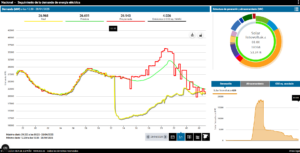Analysis of Spain’s April 2025 Blackout: Causes, Low-Inertia Grid Risks, and Protection Solutions
1. Summary of the event
On April 28th, 2025, Spain experienced a massive electrical blackout that affected the entire Iberian Peninsula, disrupting electricity supply across Spain and its interconnections with Portugal and France. According to Red Eléctrica de España (REE), the event was triggered by a sudden loss of 15 GW of generation within just five seconds at 12:33 PM, representing approximately 60% of the system’s online generation at that moment (REE, Preliminary Event Report, April 2025).
This rapid imbalance between generation and demand led to an immediate frequency drop and the activation of automatic protection systems across the grid. Official data shows a dramatic decline in recorded demand from 26,968 MW to under 13,000 MW within minutes (REE, Demand Graph, 28/04/2025). Full restoration of service extended into the early hours of April 29th.
This incident marks one of the most significant electric grid collapses in Spain in recent decades.
2. Power system operation: balancing generation and demand
An electrical power system must maintain a continuous real-time balance between generation and demand. Any instantaneous mismatch directly impacts the system’s frequency, with Europe’s nominal frequency set at 50 Hz.
-
If generation exceeds demand, frequency rises.
-
If demand exceeds generation, frequency drops.
The system’s ability to resist sudden frequency deviations depends on its inertial response, traditionally provided by synchronous generators (nuclear, thermal, large hydro plants) whose spinning masses store kinetic energy. These rotating masses act as a natural buffer, slowing down the rate of frequency change after a disturbance.
In low-inertia systems, frequency variations occur much more rapidly, leaving less time for operators or automated systems to react and correct imbalances.
3. The generation mix prior to the blackout: a low-inertia context
At 12:30 PM on April 28th, 2025, according to REE data, Spain’s generation mix was as follows:
-
Solar photovoltaic: 18,068 MW (53.34%).
-
Wind and hydro combined: approx. 20%.
-
Combined cycle gas turbines (CCGT): 1,635 MW (4.82%).
-
Other technologies: remaining contributions (biomass, cogeneration, etc.).
(Source: REE, Generation Dashboard, 28/04/2025)
This generation profile reflects a system highly reliant on non-synchronous generation, particularly solar PV connected via power electronic inverters. Unlike synchronous machines, inverters do not contribute natural rotational inertia since they lack a physical spinning mass coupled to the grid frequency.
Moreover, with only 4.82% of generation from combined cycle gas turbines and minimal participation from other synchronous generators, the system’s ability to provide kinetic energy reserves was critically low at the time. Synchronous generators are vital because their spinning rotors can release or absorb kinetic energy following a disturbance, reducing the rate of change of frequency (RoCoF, or df/dtdf/dt).
Under these conditions, any sudden imbalance would result in much faster and deeper frequency deviations, increasing the likelihood of triggering protective disconnections (Bollen, Understanding Power Quality Problems, IEEE Press, 2000).
4. Hypotheses for the initiating event: overfrequency vs. underfrequency
4.1. Overfrequency triggered by sudden load disconnection
In this scenario, a significant and abrupt load loss (such as a major industrial zone, a large city, or even an international export interconnection) caused an immediate generation surplus.
This surplus led to a frequency increase (f>50Hzf > 50 Hz). In a high-inertia grid, this rise would have been dampened by kinetic energy absorption from synchronous generators. However, in a low-inertia system, the rate of frequency rise (df/dtdf/dt) is much higher, quickly triggering overfrequency protection systems, typically set between 50.2 Hz and 51 Hz in European grids.
These protections disconnect generation to reduce frequency. But if the response is uncoordinated or excessive, too much generation is disconnected → frequency drops below nominal → underfrequency protections activate → cascading shutdown → total collapse.
Key electrical parameter: crossing of overfrequency protection thresholds (>50.5 Hz) causing widespread automatic generation disconnections.
4.2. Underfrequency triggered by sudden generation loss
Alternatively, the initiating event could have been a sudden generation disconnection, such as:
-
Tripping of solar PV or wind farms.
-
Transmission line faults isolating generation zones.
-
Protection system malfunctions disconnecting generation.
The resulting deficit caused frequency to drop (f<50Hzf < 50 Hz). In a low-inertia system, this drop was rapid and steep. When frequency fell below underfrequency protection thresholds (typically 49.5 Hz to 49 Hz), underfrequency load shedding (UFLS) was activated to disconnect load and rebalance the system.
However, if the initial generation loss was too large, or if UFLS responses were insufficient or delayed, frequency continued to decline, causing further protection trips and a cascading blackout.
Key electrical parameter: rapid rate of frequency decline (df/dt) exceeding UFLS capacity to stabilize the system.
5. Potential origins of the initiating disconnection: examples and analysis
5.1. Possible causes of sudden load disconnection (overfrequency scenario)
-
Transformer or substation failure isolating an entire region.
-
Sudden disconnection of international exports: if Spain was exporting power to France or Portugal and the interconnector tripped, that exported load would instantly vanish from the Spanish system, creating surplus generation.
-
Misoperation or coordination failure of low-voltage protection systems, unintentionally expanding the affected area beyond the original fault.
Example: The 2006 European blackout originated from a planned line disconnection in Germany that unintentionally isolated large regions, cascading across the grid (UCTE Final Report, 2007).
5.2. Possible causes of sudden generation disconnection (underfrequency scenario)
-
Automatic shutdown of solar PV plants due to voltage or frequency anomalies.
-
Simultaneous tripping of multiple transmission lines isolating generators.
-
Protection relay or SCADA system misoperation causing unintended generator trips.
Example: In the 2016 South Australia blackout, multiple transmission line faults combined with inverter-based wind farm protections led to a rapid cascade of generation loss and system collapse (AEMO, Black System Report, 2017).
6. Solutions to increase system resilience
Regardless of the initiating cause, this blackout highlights the need for modernizing grid operation under high non-synchronous generation. Solutions include:
-
Mandating synthetic inertia contribution from renewable plants via advanced inverter controls.
-
Deploying fast-acting energy storage systems (batteries, supercapacitors) strategically across the grid.
-
Implementing virtual synchronous generators to replicate inertial response at critical network points.
-
Upgrading frequency and voltage protection schemes to reflect low-inertia system dynamics.
-
Improving coordination between generation tripping and load shedding protections, using adaptive algorithms.
-
Enhancing real-time grid monitoring with phasor measurement units (PMUs) and wide-area measurement systems (WAMS).
7. Improving protection system testing: an essential strategy
In addition to grid-scale measures, enhancing the reliability and responsiveness of protection systems (relays) is critical. Many of the protection failures or delayed actions in both hypotheses could be mitigated by more rigorous, scenario-based relay testing.
A key solution is to implement routine and scenario-driven testing of protective relays, including under-frequency, over-frequency, and load-shedding schemes, using advanced relay test equipment capable of simulating dynamic grid conditions.
By validating protection responses under varying rates of frequency change (df/dtdf/dt) and multi-event scenarios, utilities can:
-
Detect misconfigurations or coordination gaps.
-
Adjust setpoints based on evolving grid inertia and topology.
-
Ensure timely and appropriate activation of protection schemes during disturbances.
Such testing practices improve the system’s capacity to contain localized disturbances and prevent cascading failures, especially in grids dominated by inverter-based resources.
Conclusion
Spain’s April 28th, 2025 blackout underscores the vulnerability of modern low-inertia power systems to both overfrequency and underfrequency events. Both hypotheses—a sudden load loss leading to overfrequency, or a sudden generation loss causing underfrequency—are technically plausible and reveal critical challenges in protection, coordination, and inertia management.
The energy transition demands not only increasing renewable generation but also reinforcing system stability through improved protections, synthetic inertia, fast-response reserves, and enhanced testing protocols to ensure a secure and resilient grid.
References:
-
Red Eléctrica de España, Preliminary Event Report, April 2025.
-
Red Eléctrica de España, Generation and Demand Dashboard, 28/04/2025.
-
Kundur, P., Power System Stability and Control, McGraw-Hill, 1994.
-
Bollen, M., Understanding Power Quality Problems, IEEE Press, 2000.
-
UCTE Final Report, 2007.
-
Australian Energy Market Operator (AEMO), Black System South Australia, 2017.
cantiktoto
cantiktoto
cantiktoto
restoslot4d
totoagung
cantiktoto
restoslot4d
amintoto
restoslot4d
amintoto
totoagung
toto slot
totoagung2
totoagung2
gacor4d
sakuratoto
agen toto
qdal88
totoagung
totoagung2
restoslot4d
slotgacor4d

